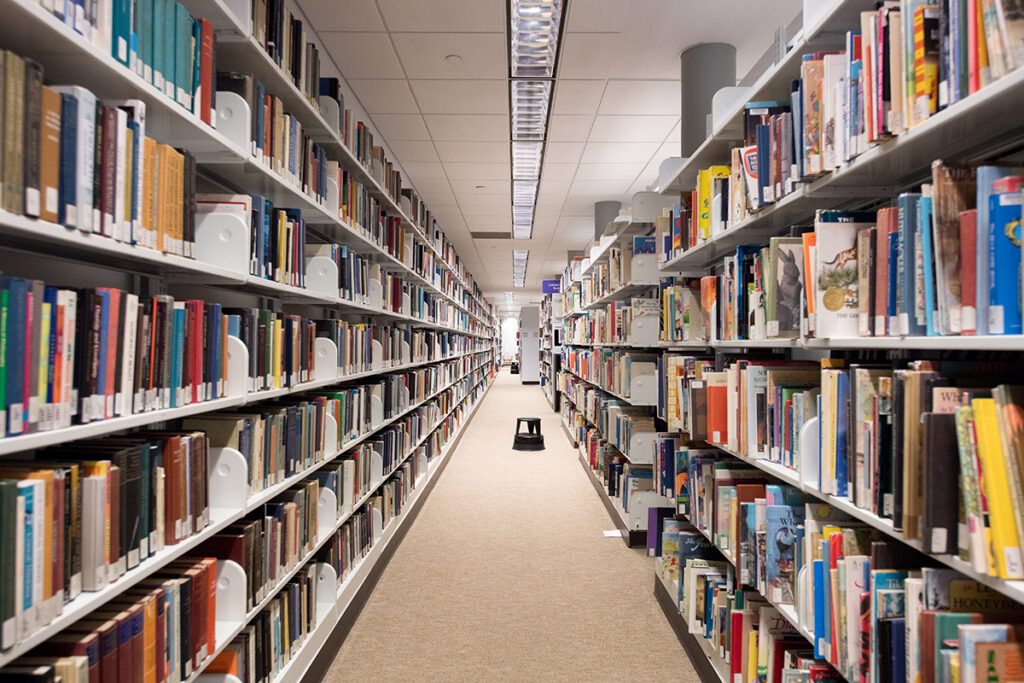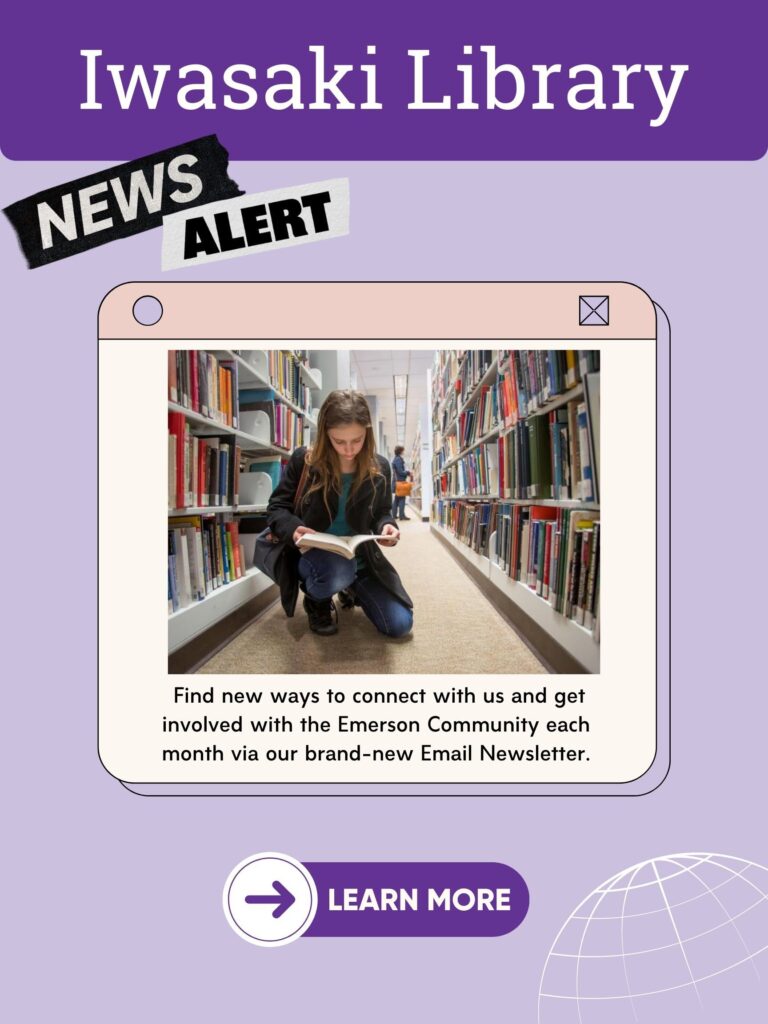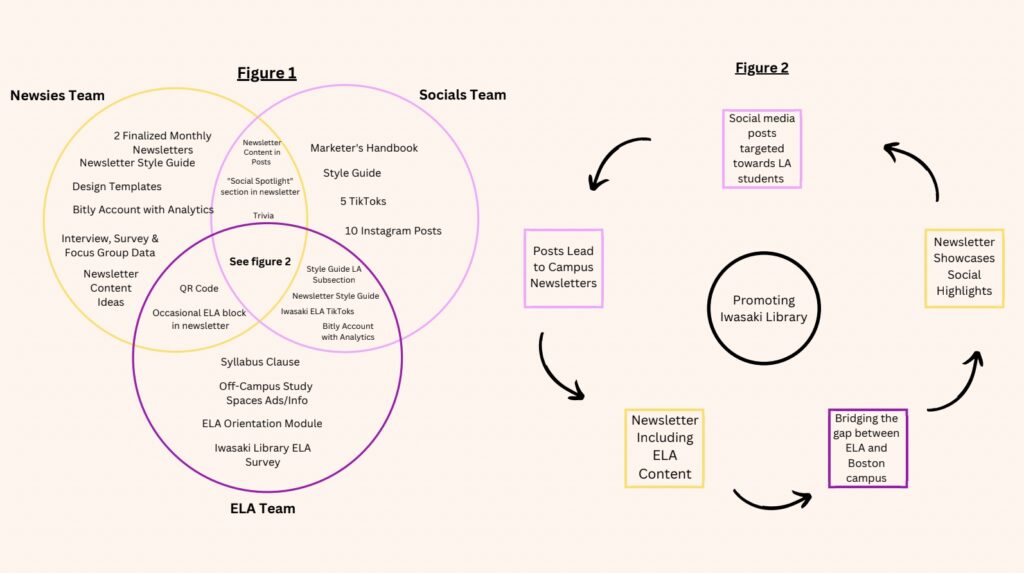Every Trick in the Book: BCE Seniors Help Iwasaki Library Lure Students

During the fall of his sophomore year, as students returned to a socially distanced campus, Richard Lathrop ’23 took a class held in the Iwasaki Library, where he found himself several times per week.
Since that semester? “I had been back maybe five times,” said Lathrop, a Business of Creative Enterprises (BCE) major.
Lathrop isn’t alone among his peers. During the pandemic, the library expanded its online services and beefed up its digital and streaming content, which students, scattered as they were around the globe, took advantage of. Once everyone returned to campus, however, they weren’t using the library at the same level.
But as a student in Executive-in-Residence Bob Lyons’ Senior Capstone class, Lathrop and his classmates were well equipped and uniquely positioned to help the library change that. During the 2022-23 academic year, the students created a marketing plan for the Iwasaki Library that includes social media assets, a branded newsletter, an online orientation module, and more.
“I don’t speak the language of the target audience, which is the students,” Library Executive Director Cheryl McGrath said. “So I was really excited to get the student perspective on what would [resonate with] the student brain.”
Typically, Capstone courses have put students to work on behalf of external clients, but Iwasaki provided the class with an interesting problem and a wealth of data on everything from foot traffic to circulation, to free periodical registrations.
“I put a big emphasis on data-driven analysis in my classes,” Lyons said, “and when I started learning what these guys had … it was perfect.
“And it was a familiar setting, they all had some firsthand experience with it, even if it wasn’t deep, so they could bring that to the design thinking piece of the course I teach,” he said.
Divide and conquer
Once the data was analyzed and students surveyed, the class broke up into three groups. One was tasked with designing an email newsletter.

Carol Xie ’23 was in the newsletter group and said she learned how best to collect and analyze data through the capstone. Via focus groups and surveys, she and her classmates determined that the digital newsletter would be the best way to reach students.
“It’s kind of just trying to figure out how can we get back into those people’s heads,” Lathrop, also on the newsletter team, said, “and we discovered 80 percent of Emerson students actually check their email and actually read newsletters, which I did not believe.”
“I hope the newsletter can continue to provide more [information] for the students,” Xie said. “They are very helpful for students when they come in.”
Another group was in charge of social media, creating a social media handbook, a style guide, and a stable of branded Instagram posts and stories and TikTok memes featuring giant cats, Bullet Train, and The Walking Dead.
“When they presented this at the BCE Showcase, students were shouting from the audience, the audience cracked up,” McGrath said. “And then there were students shouting, ‘What’s your handle, because I wanna follow it, even though I’m graduating.’”
And because the library also was able to hire a Marketing Coordinator, the team aimed to set up the new hire for success with assets and style guides.
The third group arose from challenges to both the client and the class itself. This year, roughly a third of Lyons’ capstone spent the spring semester at Emerson Los Angeles, meaning they’d have to participate remotely. And students (and many faculty) at ELA were often in the dark about what aspects of the library they could access from across the country.
Students in the LA group created a video presentation about library services to be included in the ELA Orientation Canvas Course that students are required to take before starting classes. One thing Iwasaki can’t help ELA students with is access to study space (ELA has no physical library and limited communal study rooms), so the team came up with a guide to off-campus study spots at libraries and cafés in Hollywood.
And because many ELA faculty are working in their industries, they may not be familiar at all with the Iwasaki Library. Tierney Boyle ’23, a member of the ELA team, said she had an Entertainment Marketing professor who wanted his class to read the trade publications each week for class – pubs that cost $140-$150 per year for a digital subscription, but are free to Emerson community members through the library.
“We didn’t know we could read Variety and The Hollywood Reporter for free,” Boyle said. “We realized … there probably were students in other classes who are paying for things they don’t need to because they don’t know [what’s available].”
To bridge that knowledge gap, they came up with a “syllabus clause” that professors can include in their syllabi outlining relevant library resources – including free subscriptions to pricey industry periodicals.
Real Client, Real Issues
Lyons said one of the great things about the project, both in LA and Boston, was that students got access to the “people who had their hands on the levers,” including ELA Assistant Academic Dean Mikhail Gershovich and McGrath.
“The more they dug into it, the more excited they got and the more solutions they came up with,” Lyons said. “What’s really nice about the three projects that emerged from this class is that they all sort of self-reinforced. They all overlapped in a nice way that hopefully will create some synergy.”

The project wasn’t without hiccups, however. When the class proposed installing a café in the library – a reasonable suggestion to lure students back and give them quick intra-class meal options – they ran up against the fact that there was no plumbing on the side of the library where it would have to go. When they suggested more greenery to make the space welcoming and soothing, McGrath had to break it to them that plants attract bugs – which also eat books.
“What do you do when you have these beautiful ideas, and they’re so creative and energizing, you can see them on the back of your eyelids when you close your eyes … [but] the client says, ‘no way’? That actually happened,” Lyons said. “It was great to let them pivot.”
Boyle said she and her classmates found that opportunity to “kill their babies” and switch gears really valuable.
“We were really grateful that we had a client that was supportive of everything we did, and that was surprising … to have a client who in every meeting was willing to listen to our ideas and also create a space where, if we had an idea that wasn’t doable, we could have that conversation without it backfiring on us,” she said.
McGrath sees the students’ work as having legs.
In addition to giving the library’s new Marketing Coordinator a solid foundation on day one, the McGrath is looking to use what the class produced to pilot ways to reach other corners of the Emerson community, including Kasteel Well and Global Pathways programs. They’ll pilot a campaign aimed at students doing the Imagining Ghanaian Culture Through Visual & Multimedia Storytelling trip this July, she said.
The modern library is nothing like what many people have stuck in their heads, McGrath said. It’s not just a repository for books, it’s a multimedia, multimodal center for learning and discovery and it has so much to offer beyond sources for school projects.
“The amount of times, after [the class] started researching us, they said … ‘I can’t believe I’m about to graduate and I’m just now learning about all these resources that were available,’” she said. “They got really motivated, I think, to help the students coming after them.”
Categories